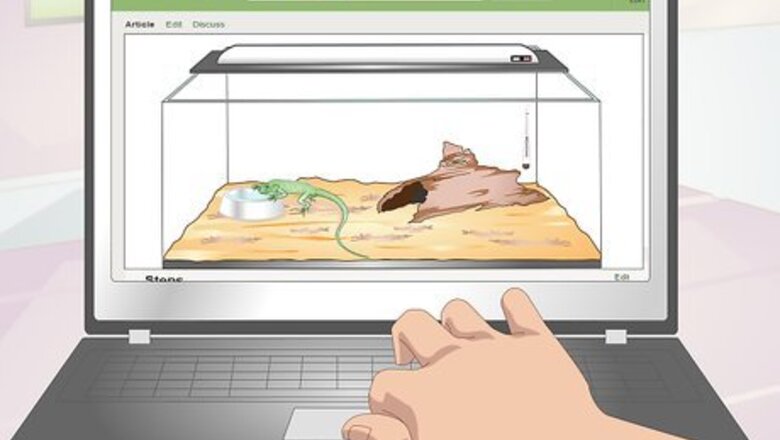
views
Planning Your Cage
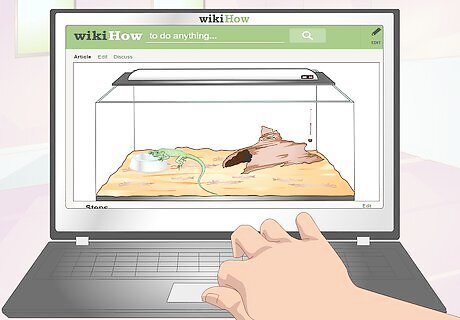
Research the iguana lifestyle. The environment an animal needs to thrive as a pet depends on several factors, including: The size of the adult animal. Most people purchase a baby iguana when it is only a few inches long, but adult iguanas can reach 20 pounds and 5-7 feet from the tip of their tail to their nose. They live to be about 20 years old and reach their full size at about 2-3 years. It is crucial that iguana habitats are built to accommodate this size. The type of habitat it has in the wild. Because an animal's natural habitat is ideal for its temperament, habits, and adaptive traits, the environment you construct must mimic the natural habitat to the greatest extent possible. Wild green iguanas are naturally found in rain forests throughout Mexico and Central and South America. Its habits. In the wild, iguanas live in trees and rarely come to the ground. They are good jumpers, and they enjoy swimming. They are diurnal, which means they sleep at night and are active during the day, and because they are cold-blooded they tend to sunbathe in the morning to raise their body temperatures. Knowing these features of iguanas can help you to prepare the optimal environment.
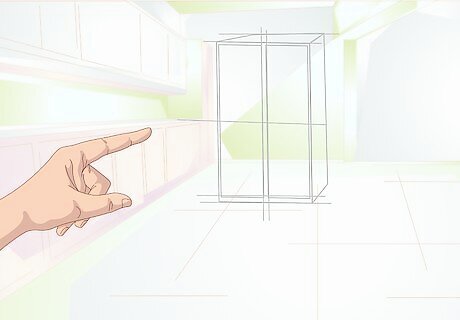
Plan where your cage will go. Because iguanas can grow as large as 6 feet (1.8 m) from head to tail, an enclosure must be quite large in order for the adult iguana to have room to move around and explore. In general, this means the cage will need to be about 6 feet high, 3-6 feet wide, and 10-12 feet long. The height is crucial, since iguanas live in trees and the enclosure must contain perches or branches for it to climb. Most iguana owners reserve the length of a wall for their iguana's enclosure. The enclosures generally need to be too high and heavy to place them atop furniture.
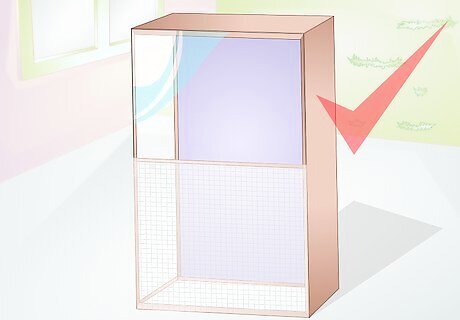
Consider the type of enclosure that is right for you. As long as they are large enough and kept at the right temperature, iguana enclosures can be made from a variety of materials including plastic wire, Plexiglas, or even a large re-purposed china cabinet. One thing to keep in mind is accessibility. You will need to easily put food and water inside the enclosure, and you need to be able to clean and disinfect the entire habitat (floors, walls, branches, food dishes, etc.) about once a week. Be sure that the enclosure you design is accessible for these purposes. Keep in mind whether or not the enclosure will be seen by visitors to your home. This can help you make a decision about how fancy or simple it should be, and whether or not you should take the time to design an enclosure that will blend with the decor of your home.
Creating a Blueprint and Purchasing Supplies

Create a blueprint for the layout of the cage. Using graphing paper, draw the front, sides, top, and bottom of the cage to scale. It is simplest to create a rectangular design, but a more experienced builder can create any design as long as it is tall and wide enough. Be sure to include where you will place a door, several branches or perches, a light source at the top on one side (it should keep one side warm and the other side less so, so the animal has a place to go to cool down), and a water source at the bottom. Consider making one side or wall removable for easy cleaning, as the entire cage will need to be disinfected weekly. Some people build a large, human sized door into the enclosure, so that they can easily step inside to clean it or spend time with their pet.
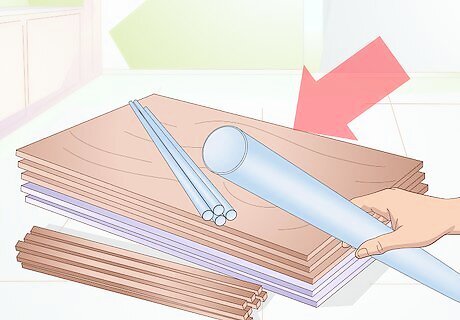
Choose your materials. Because iguanas spend most of their time in the branches, the frame and walls can be constructed from a variety of materials. The frame can be constructed of PVC pipe or wood. Use standard hard woods that come in 2x4s like pine or spruce, but avoid aromatic woods like cedar or redwood which contain oils that can be dangerous for iguanas. Most people construct their enclosure walls from Plexiglas, plastic mesh (not wire, unless it is covered with plastic, as it can hurt your iguana's toes), or tempered glass so that they can see their iguana, but this is not strictly necessary. You can use solid wood if you choose. PVC pipe and plastic mesh (or wire mesh covered in plastic) is a good plan for a cage that can be rolled outdoors on warm days. However, Plexiglas or glass will get too hot inside from the greenhouse effect, so plan to keep a Plexiglas or glass enclosure indoors. Consider building your enclosure on wheels to make moving it easier.

Purchase your supplies. You will need lumber or PVC pipe for the frame, plastic mesh or Plexiglas for the walls, pre-made perches or sealed wood branches, tools for construction, and a heat lamp and water source for the completed enclosure. Purchase enough lumber or PVC pipe to build a cage according to your blueprint measurements, but at least 6 feet high, 3-6 feet wide, and 10-12 feet long. If you're using PVC, consider buying special fittings like the "3-Way Ell" which is a joint that connects the angles of the structure. Purchase enough plastic or plastic-covered wire mesh, Plexiglas, or tempered glass for your floors, walls, and ceiling, along with glue or PVC cement to seal it to the frame. If you're using mesh, you can also dry-fit the mesh to the frame using zip ties. Purchase or make perches. These are available widely at pet stores and online, or they can be simple wood branches that are stripped and sealed. Just be sure that they are made from safe woods such as spruce or fir. Get a saw or hacksaw, to cut the wood or PVC frame to length. You can also ask the home supply or hardware store if they can cut the wood or PVC for you, as long as you know your correct measurements. You will also need some side-cutters or electrician's pliers to cut the mesh if you're using it, and wood stain (if desired) and a water-based polyurethane sealant if you're building with wood. Purchase a heat lamp, available at most pet stores. An adult iguana will need a hotspot of at least 120 degrees Fahrenheit that includes both UVA and UVB light. You can use a special heat lamp that fits these specifications from the pet store, or build your own fixture using fluorescent tubes. One reliable and simple option is to use two ZooMed 5.0 bulbs, available online, mounted in a high-quality fluorescent fixture, which can be purchased in any hardware store.
Constructing the Cage

Build the frame of your iguana cage. This will be the first step, and then you will affix the walls, floor, and ceiling to a completed frame. It’s a good idea to build this in place in the room you'll keep it in; otherwise a large enclosure may not fit through the doorway. Cut the wood or PVC pipe to your desired dimensions and affix frames for each side of the cage with glue and butt joints. Once each side of the cage has been constructed, nail or glue the sides together to create the cube. Include a door mechanism on the frame for easy access inside. This can be a removable top, a hinged door on one side, or both.
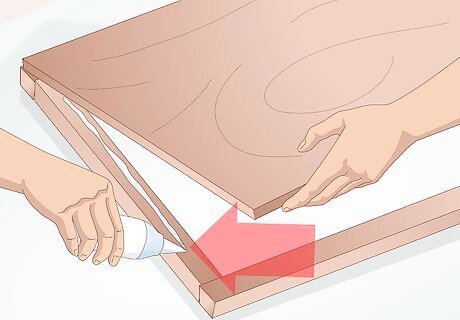
Apply a water-based polyurethane wood sealant if your frame is made of wood. This will prevent deterioration. If you plan to stain or paint the frame, be sure to seal after painting. The sealant will make the wood easier to clean and protect your iguana from fumes.
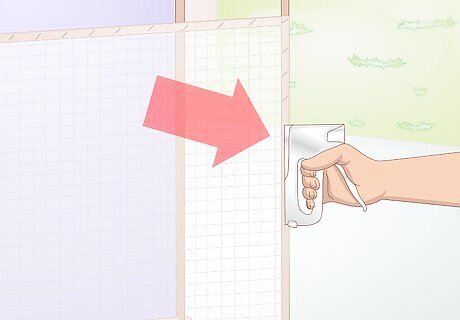
Staple the mesh to the sides of the cage, or alternately, affix it securely and tightly using zip ties. Make sure to leave no more than 1/2-inch (1.27 cm) holes in the walls. If you are using Plexiglas or tempered glass, glue it to the frame instead of stapling it. Cut and nail additional wood to place over the corners of the frame if using mesh as a side material.
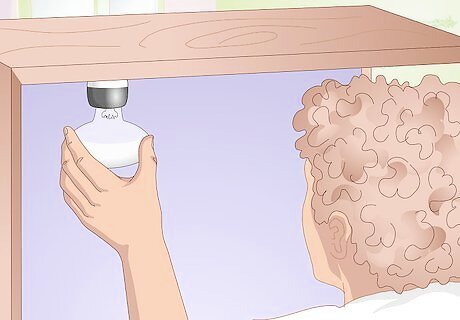
Affix the heat lamp inside the iguana cage. It should be at the top and off to one side, so that the iguana has a warmer and cooler region in the enclosure. The heat source must be located no more than 8" above where the iguana will spend its time basking (generally the top of the enclosure), because iguanas have sensors on their foreheads that regulate how frequently they need to bask. Affix the heat lamp to the top of the enclosure using zip ties, ensuring that cords extend on the outside of the cage. Be sure that if the fluorescent bulbs are exposed, you cover them with a wire bulb guard to prevent your iguana from touching the bulb and burning its skin. You should also install a couple of reliable thermometers in various locations in the enclosure to ensure that it is kept at the right temperature, which is crucial to iguana health. Under the basking light should be low to mid 90s (Fahrenheit) and the rest of the enclosure should be no lower than 80 degrees.
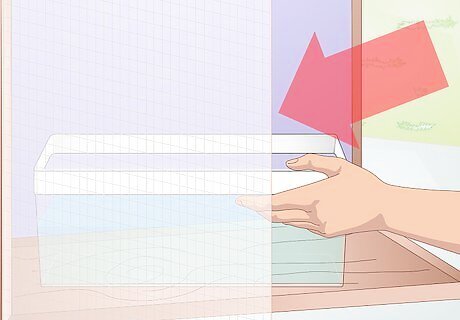
Place a water source inside the cage. In the wild, iguanas are excellent swimmers, and actually stay hydrated in part by soaking in water. You can use a large bowl or other container filled with water. Iguanas need a water source that is not only for drinking but also big enough to climb inside.

Install a ramp, shelving, perches, or branches, or add small trees inside the cage. You can attach these using secure zip ties or additional glue. Iguanas like to climb and bask in heat. They need exercise and the ability to get closer to the heat lamps to digest their food. Be creative, but ensure that it is accessible to the iguana. Branches and layers in the enclosure should ensure that the iguana can move to a variety of temperature zones by getting closer or farther from the heat source. For safety, the branches should be as wide as the width of your iguana.
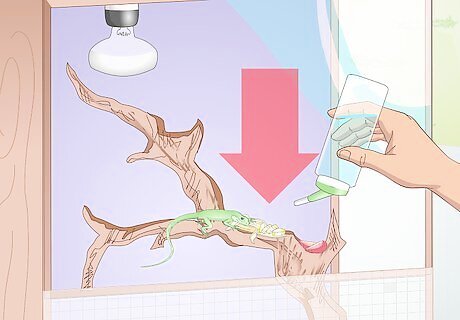
Put the finishing touches on your enclosure. Before putting the iguana in its new habitat, ensure everything is put together properly for its arrival. Place newspaper at the bottom of the cage for easy cleanup. Ensure that there is fresh water in the bowl and plenty of food. Iguanas are strict herbivores and enjoy a varied diet of consisting of mostly vegetables (primarily leafy green vegetables), some fruit, and an occasional treat of cooked rice, pasta, or whole wheat bread. Use a shallow bowl for food (plastic, ceramic, or glass will work fine) and change it daily.




















Comments
0 comment